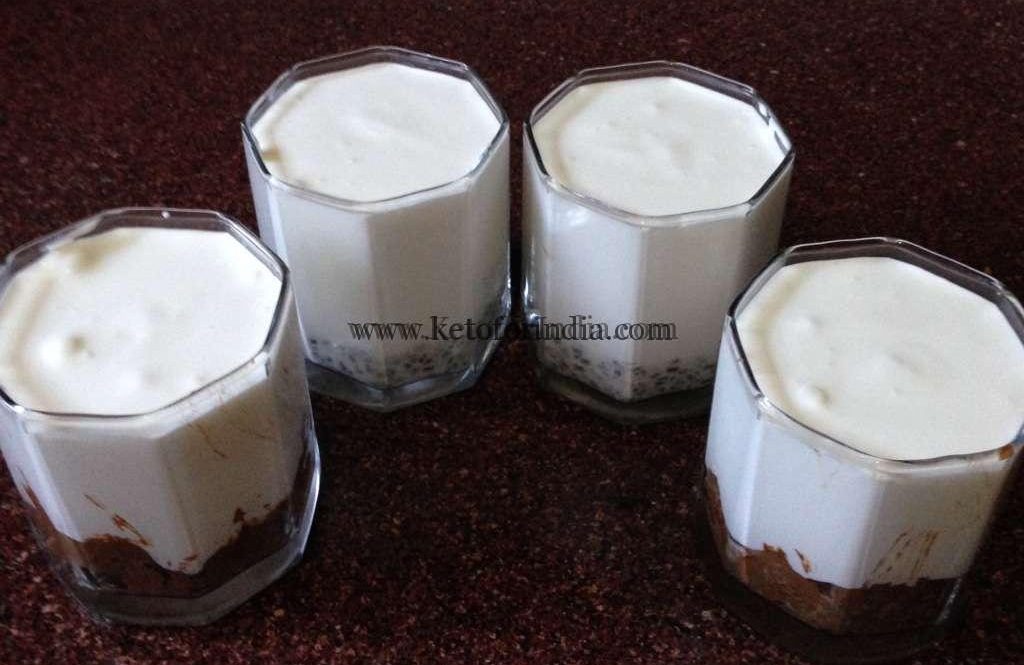Last updated on January 24, 2025
I have introduced you to a keto dessert; try this easy & sugar-free Keto chia seed pudding. Make it with just four ingredients: chia seeds, coconut milk, butter, & cream.
Chia seeds have become a staple in the world of Keto, and while I may be a little late to the party, I am an enthusiastic participant. Since adopting the Keto lifestyle, I’ve had countless stories and recipes featuring chia seeds.
So, why not give the Keto Chia Seed Pudding a try and treat yourself to a glass of goodness?
I’ve had a small batch of chia seeds sitting in my pantry for a few months now, and I’ve been eagerly searching for the perfect idea to put them to use.
Before I delve into the recipe, I want to share some good news with my fellow Indian friends:
Chia seeds are now readily available in grocery/kirana stores across India.
Keto Grocery List PDF
So, the next time you go shopping for your Keto essentials, be sure to add them to your list. Even 100 grams will suffice for your chia seed journey.

Now, let me introduce you to another ingredient that I have recently discovered and consider to be divine. It’s a worthy replacement for heavy whipping cream (HWC) in India.
Some of you may already be familiar with it, but I am ecstatic as I just stumbled upon it yesterday. Allow me to introduce you to ‘Amul Whipping Cream.’ It contains 30% milk fat and, best of all, it is completely sugar-free. With this delightful ingredient in hand, we can elevate our Keto recipes to new heights.

I made four portions of this dessert, and I had to finish one full portion before I could share my happiness with you.

Keto Chia Seed Pudding Recipe
Equipment
- Bowl
- Spoon
- Glasses
Ingredients
- ¼ cup Chia Seeds
- 2 tbsp Unsweetened Cocoa Powder Hershey’s (optional)
- 200 ml Dabur Homemade Coconut Milk
- 200 ml Amul Whipping Cream
- Vanilla Extract Optional
- Sweetener of your choice
Instructions
- Take the Chia seeds in a bowl and add the coconut milk to it.
- Keep mixing with a whisk until it combines nicely.
- Add the sweetener and whisk some more.
- Divide the mixture into two portions.
- I added cocoa to one half and mixed it nicely.
- Now pour this mixture into the bowls or glasses you would like to eat in.
- Keep covered in the refrigerator for 12 hours.
- Next morning, beat the cream and put it on the Chia seeds mixture.
- You can either eat it right away or allow the cream to settle in an hour or so.
Notes
I added unsweetened Cocoa to half of the mixture and let the rest be plain coconut. Some recipes asked for vanilla extract or cinnamon powder, but I didn’t use any. I love the natural taste and smell of whipped cream.
You can also make this pudding with almond milk, but I don’t get almond milk here, so I was happy to use coconut milk. I did not use a blender, but if you want to, please go ahead. I love the texture of Chia seeds, if you don’t like it, please go ahead and blend them.
The only thing you need to be careful about is the proportion of Chia seeds to the liquid. When you start mixing the seeds with coconut milk, ensure the mixture has a free-flowing consistency. The seeds will swell up in twelve hours, so some extra liquid is essential.
Make this pudding in the night so that it is ready for breakfast or as a snack. They stay fine in the fridge for a few days if you can resist them for that long. If you try this recipe, send me a picture; I would love to see how yummy your pudding looks.
Happy pudding making!
Benefits of consuming Chia Seeds on Keto
- Chia Seeds are often called super seeds from Mexico since they offer many nutrients with few calories.
- The carb content in Chia seeds is primarily fiber.
- Seeds are loaded with antioxidants.
- They offer you good quality protein.
- Seeds have very high levels of omega-3 fatty acids.
- They are known to help in Type 2 Diabetes.
- They are versatile ingredients and can be very easily incorporated into any diet.
A single ounce of Chia seeds or 1 ounce (37.8 g) has:
- Fiber: 11 grams
- Protein: 4 grams
- Fat: 9 grams (5 of which are Omega-3 s)
- Calcium: 18% of the RDA
- Manganese: 30% of the RDA.
- Magnesium: 30% of the RDA.
- Phosphorus: 27% of the RDA.
You will also find a decent amount of Zinc, Vitamin B3 (Niacin), Potassium, Vitamin B1 (Thiamine) and Vitamin B2, in them.


 5 Minutes
5 Minutes  4
4












